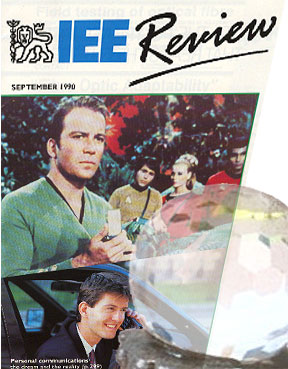A Cambridge perspective
on the digital world



December 2002
"You can't predict the future. With all this technical change, you can't possibly know what will happen next year, let alone in ten year's time." Well, perhaps you can - or at any rate, we can.
 Take
the mobile phone, for example, now used by 70% of the British population.
Was this a surprise? A dozen years ago, the only mobile handsets to be seen
in public were on the set of Star Trek. Transporters and starships will remain
science fiction for a few decades yet. But in 1990 our senior partner predicted,
in a cover article for the IEE Review, that the 'personal communicator' would
become a reality around the end of the century; and that it would be a low
priced ("perhaps £50") consumer device. Unlike Captain Kirk's
standard issue communicator, it would be a fashion item, "produced in
many different shapes, colours and styles to suit different types of people,
and perhaps even different moods". The prediction, like others we have
made, was based on hands on experience. In this case it was the experience
of developing the world’s first digital portable phone, the first such
device designed for mass production as a consumer item. We could predict the
future because we knew it was possible. From that point on, it was simply
a question of repeating the exercise - a few hundred million times - and applying
some basic principles of economics and marketing. A dozen years on, this is
exactly what has happened - as predicted, and on schedule. About one in six
of the world's population - one billion people – now have a mobile phone,
virtually all of them based on digital technology. In 1990 this still looked
to many like science fiction; but we knew the reality.
Take
the mobile phone, for example, now used by 70% of the British population.
Was this a surprise? A dozen years ago, the only mobile handsets to be seen
in public were on the set of Star Trek. Transporters and starships will remain
science fiction for a few decades yet. But in 1990 our senior partner predicted,
in a cover article for the IEE Review, that the 'personal communicator' would
become a reality around the end of the century; and that it would be a low
priced ("perhaps £50") consumer device. Unlike Captain Kirk's
standard issue communicator, it would be a fashion item, "produced in
many different shapes, colours and styles to suit different types of people,
and perhaps even different moods". The prediction, like others we have
made, was based on hands on experience. In this case it was the experience
of developing the world’s first digital portable phone, the first such
device designed for mass production as a consumer item. We could predict the
future because we knew it was possible. From that point on, it was simply
a question of repeating the exercise - a few hundred million times - and applying
some basic principles of economics and marketing. A dozen years on, this is
exactly what has happened - as predicted, and on schedule. About one in six
of the world's population - one billion people – now have a mobile phone,
virtually all of them based on digital technology. In 1990 this still looked
to many like science fiction; but we knew the reality.
The proof that digital portable phones could be mass produced cheaply led to the creation of new businesses using mobiles to compete with the traditional wired telephone, and to the emergence of the competitive telecommunications market we see today. Mobiles now outnumber wired phones and are the dominant form of telecommunications worldwide.
Equally controversial at the time was the prediction that CDs would become the way to distribute all kinds of information, and would be cheap enough to be given away with the cornflakes. So was the statement that networks - then a technical curiosity - would become the standard way for businesses to communicate. So it has turned out; and mobile phones, digital information and networks (including the Internet) have changed the way we live and work more than anything else in the past decade.
Over the years we have tracked and predicted the consequences for business, society, institutions and people. Sometimes we have done more. Showing that something new is possible, communicating it effectively - and where necessary proving that it can actually be done by doing it - can shape the course of future events, and have an impact on the lives of millions worldwide.
Among other things, we predicted the development of digital video that would fit on a compact disc and be cheap enough for consumer use - and we presented the leading European consumer electronics manufacturer with a detailed plan of how to do it. They went on to create, with the assistance of others, the global standard that makes it possible today. The same standard has also made possible digital television, changing the media landscape for ever.
We predicted the growth of wireless LANs, and participated in the early development of standards to make them possible. They are now showing explosive growth. We predicted the convergence of mobile phones and computers to create a new generation of portable devices, and identified some of the forms these devices would take and how they would be used. As reported by the Economist, these new devices are now the focus of a battle royal between Microsoft and Nokia for dominance of a new industry, an industry which both acknowledge has taken over from the PC as the spearhead of global technical development. Truly personal in the way that the ‘personal’ computer never was, these devices will become our individual point of contact with the world beyond our immediate physical surroundings. They will grant access to the wider world through the twin agencies of digital information and digital networks, which the past thirty years have served to create through innovations such as those mentioned above.
And what will happen next year, and the year after that? The drive to ‘personal’ technology is far from over. But the products and services now coming to market have been in development for some time: we know what they are, and we have predicted the effect they will have.
